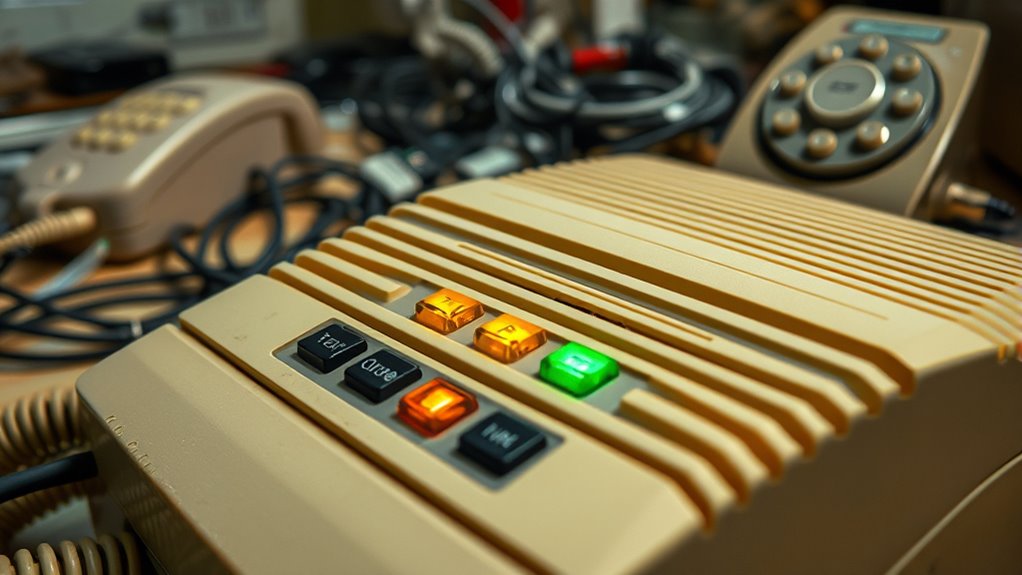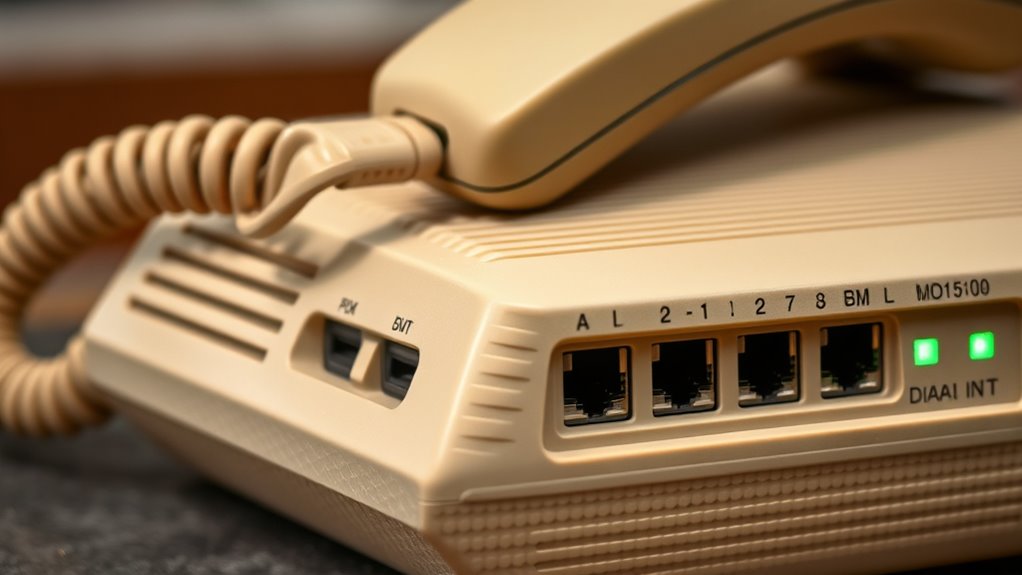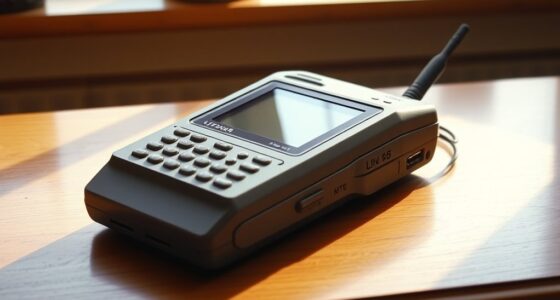When you hear the familiar screech of a dial-up modem, it signals your home is about to connect to the internet. This sound results from the modem’s handshake process, where it communicates with your service provider to establish a data transfer link over traditional phone lines. While slow and noisy, this connection marked an exciting chapter in digital history. To uncover more about the fascinating story behind this iconic sound, keep exploring further.
Key Takeaways
- The screeching sound was the handshake process establishing a connection between the modem and the ISP.
- It signified successful communication and the start of an internet session in the early digital era.
- The sound resulted from analog signals exchanged during protocol negotiations over telephone lines.
- Each distinctive noise marked a step in establishing data transfer and network authentication.
- The iconic screech remains a nostalgic symbol of the pioneering days of home internet access.

Dial-up modems were the primary way people connected to the internet before broadband became widespread. If you grew up in the 1990s or early 2000s, you probably remember that distinctive screeching sound that kicked off every online session. That noise wasn’t just an annoyance; it was a symbol of the early days of internet connectivity, a nostalgic reminder of a time when connecting to the web was both an adventure and a challenge. Modem technology back then was limited compared to today’s standards, but it laid the groundwork for the digital world we now take for granted. It’s fascinating to reflect on how this technology transformed communication and information sharing, even if it often involved patience and a bit of noise.
When you think about internet nostalgia, the sound of a dial-up modem might immediately come to mind. That screech, chirp, and handshake—an audible handshake—marked the moment your computer established a connection with your internet service provider. You’d hear it every time you wanted to check your email or surf your favorite website. The process was slow by today’s standards, often taking several minutes to load a single webpage. Yet, that slowness didn’t diminish the excitement. It was a new frontier, and every successful connection felt like stepping into a vast digital universe. The technology behind it—modem technology—was primitive compared to modern broadband, but it was revolutionary at the time. It converted digital data into analog signals that could travel over telephone lines, which was a groundbreaking concept. This allowed homes worldwide to tap into the internet’s potential, opening up communication, research, and entertainment.
You probably remember how your modem would often disconnect unexpectedly or how you’d have to carefully position the phone cable just right for a stable connection. Despite these inconveniences, it fostered a sense of community among early internet users. You’d share tips on avoiding disconnections or troubleshooting the hardware. The aesthetic of those bulky, blinking modems also evokes a sense of nostalgia, reminding you of a simpler, more exploratory internet era. Each dial-up connection was an experience—full of anticipation, static, and that unmistakable sound of progress. Today, broadband has rendered dial-up obsolete, but the legacy of modem technology remains a significant chapter in internet history. It reminds you of a time when connecting to the web was an event, not just a quick click, and the screeching sound was the soundtrack of digital discovery. The connection process involved a series of handshakes that established communication protocols, which was essential for data transfer.
Frequently Asked Questions
How Did Dial-Up Modems Impact Early Internet Security?
You might not realize it, but early internet security faced significant challenges due to dial-up modems. Their connection methods left users vulnerable to password vulnerabilities and privacy concerns, as hackers could intercept signals or guess passwords more easily. This era taught you the importance of stronger security measures, prompting later innovations to safeguard your online activities from unauthorized access and guarantee your privacy while connecting through these early modems.
What Were the Main Challenges in Maintaining Dial-Up Connections?
You faced challenges maintaining dial-up connections due to poor connection stability and signal interference. Frequent dropouts disrupted your browsing, making it frustrating to stay online. Phone line quality and external noise often caused signal interference, leading to slow speeds or disconnections. You had to reconnect repeatedly, wasting time and patience. These issues highlighted the limitations of early internet technology, requiring patience and persistence to stay connected.
How Did Dial-Up Modems Influence the Development of Broadband?
You see, dial-up modems paved the way for broadband by highlighting the limitations of early internet access, prompting the push for faster, more reliable connections. This technological evolution aimed to bridge the digital divide, making online resources accessible to more people. As a result, the need for high-speed internet grew, accelerating development of broadband infrastructure and changing how you connect, work, and communicate today.
What Were Common Troubleshooting Issues With Dial-Up Modems?
You often encounter troubleshooting issues with dial-up modems, like error messages and connection drops. These problems can stem from poor phone line quality, loose cables, or outdated drivers. You might also face issues with incorrect settings or busy signals. Regularly checking your connections, updating software, and ensuring your phone lines are clear can help resolve these common problems, making your internet experience smoother.
How Did Dial-Up Modems Shape Early Online Communities?
You see how dial-up modems shaped early online communities by creating a shared space for users to connect. They fostered a sense of belonging, where online etiquette was essential to respectful interactions. As you navigated these communities, your awareness of user privacy grew, since safeguarding personal info became critical. These modems laid the groundwork for social norms and communication standards that still influence online interactions today.
Conclusion
Remember, those dial-up modems were like tiny gateways opening your world with a screech, bridging the gap between your home and the vast digital universe. Though their sound has faded, they laid the foundation for today’s lightning-fast connections, reminding you that even the simplest sparks can ignite incredible journeys. So, cherish those nostalgic echoes—they’re the roots of your connected life, whispering stories of patience, progress, and the dawn of a new digital age.









